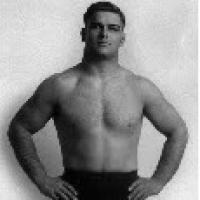An Béarlagair Iontaobhais Bunaidh
I rith na 1920idí luatha, D’fhógair Tex Rickard cogadh ar a iar-chomhpháirtí bolscaireachta dornálaíochta, Jack Curley. Chuir Curley an wrestling gairmiúil chun cinn i gCathair Nua-Eabhrac. D’eagraigh sé tionscnóirí freisin i gcathracha móra ar nós Boston agus St. Louis isteach i muinín wrestling. Rinne an t-iontaobhas rialú ar an gCraobhchomórtas Domhanda Trom-mheáchain Wrestling. An t-iontaobhas froze amach wrestler ar bith, who refused to go along with their plans.
Idir 1917 agus 1921, Curley booked four wrestlers to win the world title in worked matches with each other. Joe Stecher, Iarla Caddock, Ed “Strangler” Lewis and Wladek Zbyszko traded the world title back and forth during this four-year period. The four men could wrestle legitimately, Lewis and Stecher were elite wrestlers, but they worked the title matches.

Photo of Marin Plestina (Fearann Poiblí)
Caddock served in the U.S. Arm le linn an Chéad Chogadh Domhanda. Caddock’s service threw a further wrench into the title picture. Caddock defeated Wladek Zbyszko in his last title match before heading overseas. After Caddock left, Curley waited a few weeks before announcing Caddock sent Curley a telegram relinquishing his title. When Caddock returned from France fortunately for himself but not so fortunately for Jack Curley, Caddock let reporters know Curley made up the telegram story. Wladek Zbyszko won the match for the vacant title.
Around the time of the title controversy in 1918 agus 1919, Rickard decided to enter professional wrestling promotion. Rickard searched for a wrestler, who the trust did not control but had legitimate wrestling skills to challenge one of Curley’s champions. Rickard discovered the perfect man to be his trust buster, Marin Plestina.
Plestina wrestled his first professional matches in 1910. Martin “Farmer” Burns trained Plestina for the ring. Plestina wrestled World Champion Frank Gotch, as one of his sparring partners, every day for 2 to 3 years in Gotch’s prime. This training produced a legitimate shooter with superior submission skills.
Plestina frequently criticized the trust for failing to book him against any of their top wrestlers. As early as 1916, Plestina complained to the newspapers that Curley and company refused to book him against their wrestlers. Plestina’s financial backers offered $1,000 to Curley to put Plestina up against any of his wrestlers. Faoi dheireadh, the backers would raise the prize money to $10,000. Curley still refused.

Photo of Jack Curley from 1910 (Fearann Poiblí)
In 1919, Tex Rickard and Bernarr McFadden, a former wrestler with a large publishing house, backed Plestina with a $25,000 stake for a winner-take-all match with Curley’s champion. Curley avoided the challenge for two years before finally matching John “Tigerman” Pesek, who never was a world champion, against Plestina. Plestina won the match, but the ensuing controversy and embarrassment chased Rickard from wrestling promotion.
A personal tragedy in 1922 forced Plestina to collaborate with the different factions controlling wrestling. Plestina’s wife Barica, who went by Barbara, died at 34 nó 35 bliana d'aois. Her early death left Plestina as a single parent with three young children. Plestina wrestled worked matches for the remainder of his career.
Little information is available about Plestina’s background or personal life. Plestina was born in 1887 but we do not know his exact date of birth. Plestina lived in Chicago as an adult but we do not know where he was born. Newspapers referred to Plestina as the Austrian strongman.
Plestina did remarry and have one more child. She was the only one of his children to marry. His daughter Jennie was only 10 bliain d'aois, when she died in 1929. Plestina’s three children with Barica are buried in the same grave as Plestina and his wife.
Plestina passed away in late December 1945. The family held his funeral on December 31, 1945, before internment in the family plot at Mount Olivet Catholic Cemetery in Chicago, Illinois. Plestina was 58 bliain d'aois.
You can leave a comment or ask a question about this or any post on my Facebook page.
Sources: Collyer’s Eye (Chicago, Illinois), Aibreán 26, 1919 edition, p. 4, Chicago Tribune, December 31, 1945 edition, p. 18, Find-a-Grave.com and wrestlingdata.com

